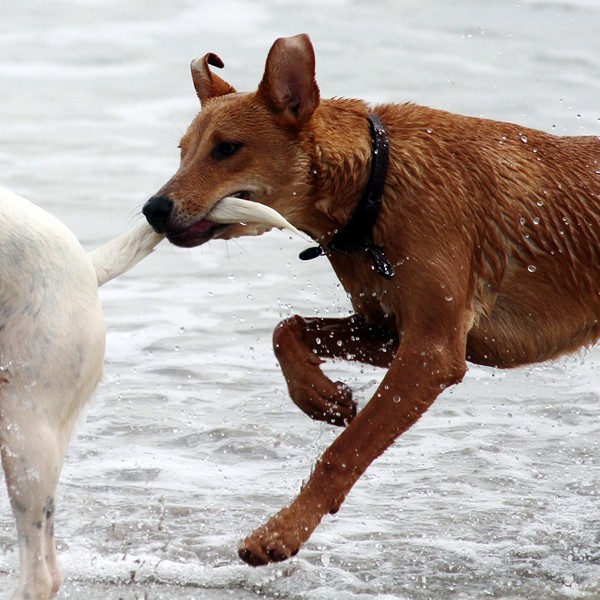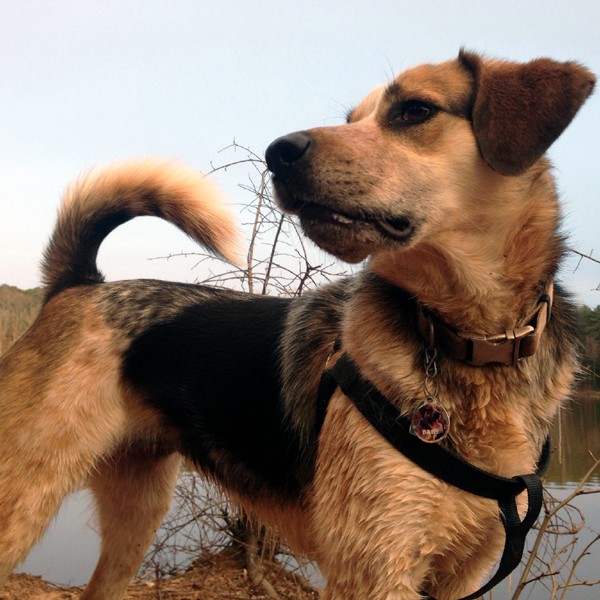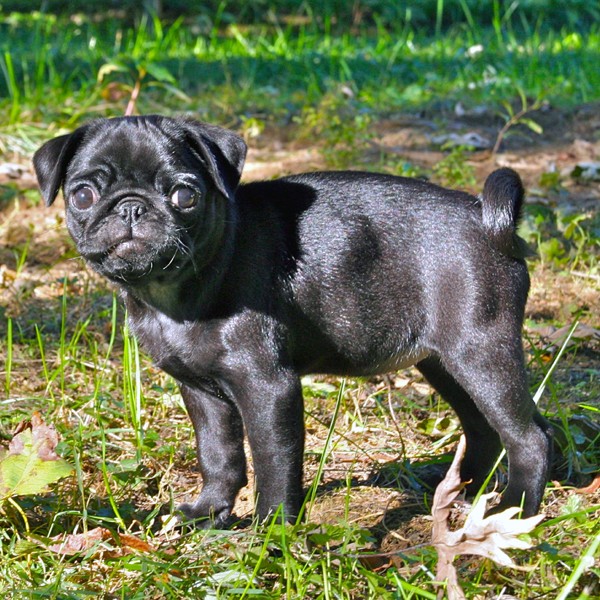Dog tails. Their sizes, length, and fur volume are as distinct and individual as the dogs who wag them. Have you ever stopped to think about — and I mean, really strike your best Rodin’s The Thinker pose and contemplate — the form or function of a dog’s tail? Unlike the prehensile tails sported by creatures as common as the possum, or as exotic as the tree pangolin, a dog’s tail can’t grab stuff. So, why do dogs have tails in the first place?

Why do dogs have tails? Are they just for chasing? (Photo via Pixabay)
Then, there’s the matter of dog tail activity. The group of snakes known as pit vipers have keratinous segments that rattle to ward off threats. Fish use their tails for a wide variety of tasks, including propulsion and navigation. By comparison, a dog’s tail appears to be relatively useless. At best, a dog’s tail smacks you in the leg when you’re seated next to each other. Why do dogs wag their tails, then? We’ve done the leg-work on dogs’ tails and hope to answer the most frequently asked questions, as well as a few others.
- Why do dogs have tails?
- Do dogs have bones in their tails?
- Why do dogs wag their tails?
Why do dogs have tails?
Since dog tails are not uniform in length, shape, or orientation, it’s safe to assume that the practical functions of a tail differ. Depending on the breed and the purpose for which it was bred, a dog’s tail can be useful help maintain balance during strenuous physical activity, assist a dog in swimming, and provide insulation against cold weather.
Dogs like Greyhounds have thin, lean tails for keeping balance at speed, while Dandie Dinmont Terriers, originally bred to pursue badgers and otters over rocky, uneven terrain, sport thicker, stockier tails. Dogs who are particularly adept at swimming, from the Labrador Retriever to the Portuguese Water Dog, have strong tails that help with navigation and propulsion along lakeshores and in marshes.

My dog Baby has a tail with real volume and character. (Photo by Melvin Peña)
For northern dog breeds, including the Akita and Alaskan Malamute, bushy tails can serve as living scarves, providing insulation for their faces against extreme cold. Tails also serve as tools for communication and self-expression, which we’ll get into below with tail position and wagging.
Do dogs have bones in their tails?
This may seem like a silly question, but you’d be surprised just how often people ask about it. Generally speaking, the tail is the one part of a dog’s body they least like to have grabbed, touched, or otherwise fondled, making it a somewhat mysterious appendage. Combine that with the tail’s whip-like, serpentine movement, and it is understandable that people might wonder whether it is composed of a more flexible material, like cartilage. Though it seems a sturdy thing, the longer it is, the more exposed it is to damage and trauma.
What is a dog’s tail made of? Whether it is long and lean, or short and curled, dog tails are direct outgrowths of the spine. The bones of the spine are called vertebrae as a collection, and are named by their placement in the dog’s spinal alignment. The tail’s bones are called the caudal, coccygeal, or simply tail vertebrae. The number of bones in the tail varies by breed or mix, but there are typically anywhere from five or six to 23 coccygeal vertebrae.

The Pug’s curled tail is an inherited malformation of the vertebrae. (Photo via Wikimedia Commons)
Short, curled tails are adorable; there’s no doubt about that, but did you know that a tight, pleasing curl is an inherited deformation, encouraged by generations of breeding practices? It is most common in brachycephalic, or short-muzzled, breeds such as the gentle Pug or the flare-eared French Bulldog. The condition is called hemivertebra — literally, “half of a vertebra.” The vast majority of dogs with this genetic anomaly are asymptomatic, but a few may suffer from rear-limb weakness.
Why do dogs wag their tails?
We’ve looked into the physical details of function and form in the dog tail. Now we turn our attentions to its performative uses, specifically, how dogs use their tails to communicate, both with other dogs and with their owners. Body language is as much a part of a dog’s repertoire as it is in humans, and the tail is a far more subtle organ of communication than barks, whines, or howls.
There are a multitude of dog tail signs, and we’ll try to untangle the possible meanings behind a few of them. We may tend to think of tail carriage and tail wagging as distinct, but the two frequently work together to convey specific details about mood and emotion along with a particular message to be conveyed. A dog with the tail tucked between the hind legs can be considered fearful, suspicious, or socially submissive.

The faster a dog’s tail wags, the readier he is for action. (Photo by halfrain on Flickr)
Carried horizontally, even with the line of the back, the tail represents a relaxed, even-tempered, or indifferent dog. A dog with his tail held upright or oriented toward the head might be excited, alert, or preparing for action. Dogs’ tails wag in each of these positions, and at all degrees in between. Wagging in an upright position, for some dogs, may actually serve a purpose similar to the rattle on a pit viper, a signal of warning to anyone or anything the dog perceives as a threat.
How fast the tail wags, the sweep of its arc, and even which side — to the left or to the right — all work together to deliver the intended message in all its complexity. According to Dr. Stanley Coren, you can best judge, or attempt to approximate what your dog is trying to “say,” not only by its position and wagging action, but also by knowing where your dog’s tail is held on a normal basis and working from there.
Dog tails: every day, they’re out there wagging
The more we learn about dog tails, the more fascinating they become. Since 2010, much of the cutting-edge research in understanding dog tail wags has been conducted in Italy. Scientists and veterinarians there have published papers not only on what wagging to the right and left might mean, but also on how dogs themselves perceive and react to directional wagging by other dogs.
If your dog is one of those poor unfortunate beasts who has had their tail docked — which is, among all archaic practices, one of the most monstrous — or if the only times you notice your dog’s tail is when it hits you in the face as the dog jumps over the couch, you’re missing out on an entire spectrum of dog conversation. Long, short, straight, curled, or bobbed, a dog’s tail has much to tell us if we have the eyes to see and a mind to decipher its mysterious patterns! What is your dog’s tail telling you?
The post Why Do Dogs Wag Their Tails? appeared first on Dogster.
No comments:
Post a Comment